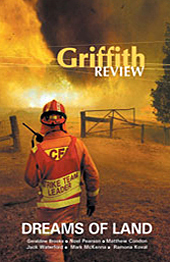Featured in

- Published 20031202
- ISBN: 9780733313509
- Extent: 236 pp
- Paperback (234 x 153mm)

Already a subscriber? Sign in here
If you are an educator or student wishing to access content for study purposes please contact us at griffithreview@griffith.edu.au
Share article
About the author

Jack Waterford
Jack Waterford is editor-in-chief of The Canberra Times.He has been a journalist for 31years, having written primarily about law, politics and public administration.He has...
More from this edition

Building relationships to care for country
EssayMAURICE BINSTEAD WOULD start to whistle every time we came into the Arcadia Valley in central Queensland. Roddy Smith is filled with peace at...

The land – dreams and disappointments
IntroductionTHERE ARE THREADS that run like arteries through a nation and in this country one is the land. It is the source of many...

The casuarina forest
EssayThe she-oak (casuarina) is a melancholy kind of tree, with feathery leaves that hang in fringes from short stems... [it] whispers and murmurs in...